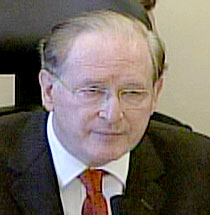2007年VOA标准英语-US Senate Tackles TV Violence
搜索关注在线英语听力室公众号:tingroom,领取免费英语资料大礼包。
(单词翻译)
By Leta Hong Fincher
Washington
27 June 2007
With studies showing that a growing number of children are exposed to graphic1 violence on television, U.S. lawmakers are considering tighter regulations on media content. But the effort faces opposition2 from entertainment executives and free speech advocates. VOA's Leta Hong Fincher reports on a Senate hearing to examine the impact of media violence on children.
A recent study by the Parents Television Council says that the last primetime television season in the United States was the most violent ever recorded. Tim Winter, president of the council says, "The depictions of violence have become more graphic, as we saw, far more realistic, thanks in part to enhanced computer graphics3 and special effects employed in TV production today. And second, there is an alarming trend for violent scenes to include a sexual element."
Winter testified at a Senate hearing on the effect of violent television images on America's children. He said the evidence is strong that children exposed to television violence are more aggressive and show a greater propensity4 for violence in later life.
Democratic Senator John Rockefeller is a vocal5 critic of TV violence. He said Congress needs to impose curbs6 on the broadcast and cable industry. "We now know that the entertainment and broadcasting industry has proven itself unable and unwilling7 to police itself. I fear that graphic, violent programming has become so pervasive8 and has been shown to be so harmful, we're left with no choice but to have the government step in."
 |
| Peter Liguori |
First Amendment11 expert Laurence Tribe of Harvard Law School argues that the government should not be given the power to decide what depictions of violence are suitable. "In the long run, it is not in the interests of my children, my grandchildren or the children or grandchildren of this or of any other generation, that we sacrifice free speech on the altar of protecting children."
Entertainment industry advocates say parents can use TV content ratings or technology to block programs with inappropriate content. But recent studies found that many parents are confused by the technology and TV ratings.
 收听单词发音
收听单词发音 




